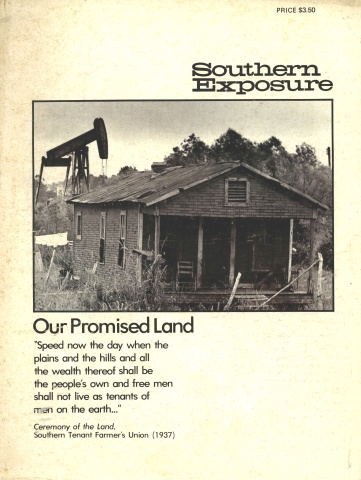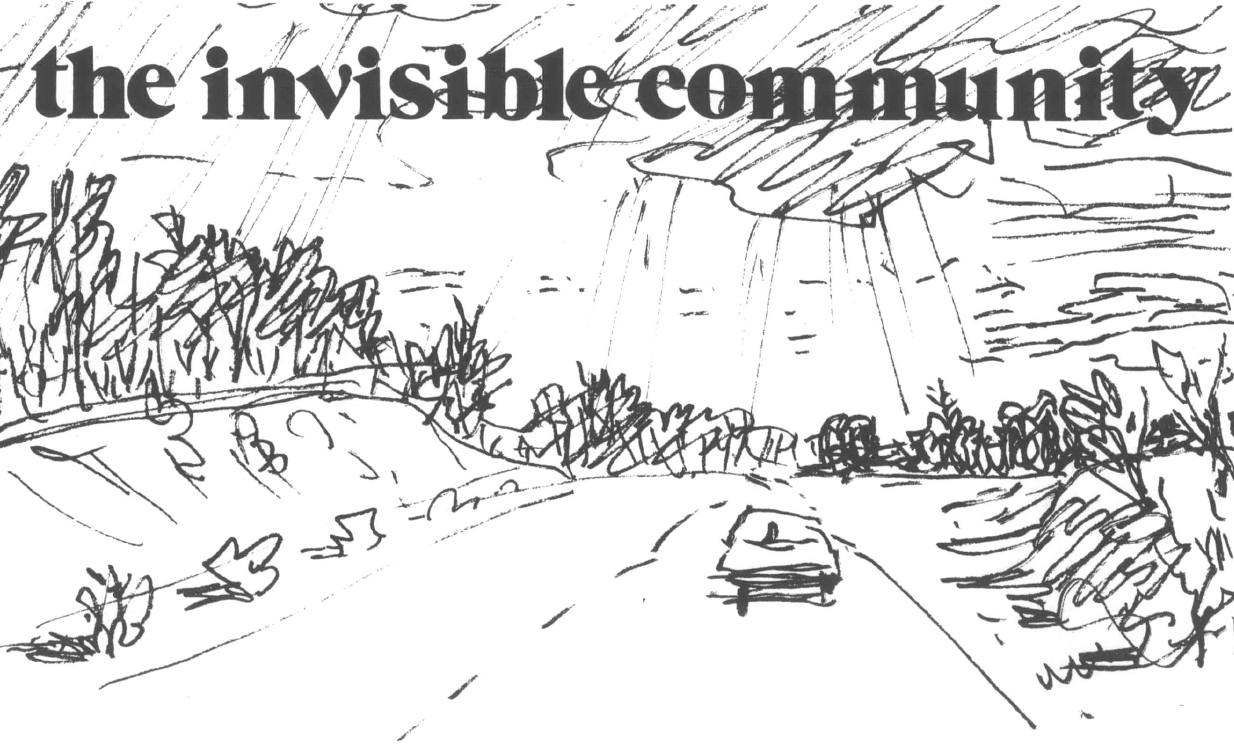
This article originally appeared in Southern Exposure Vol. 2 No. 2/3, "Our Promised Land." Find more from that issue here.
Winding down Russell Chapel Road in Chatham County, North Carolina, flanked by fields of grain and goldenrod, you come to a place where a cluster of mailboxes leans out from the hedge like the heads of ponies over a fence. A right turn will place you on what is called "the common road," which plunges down, then goes up again, through the center of an invisible community. Invisible because, if you didn't know it was there, you might miss it entirely; community, because you have just entered a 340-acre land development in which nearly thirty families either are or will be living.
The community, named more like a ship than a subdivision, is Saralyn, Wally Kaufman's answer to ticky-tacky housing and environmental protection. Landowners here not only can escape from the split-level syndrome, but can enjoy the security of knowing that the property around them will remain as nearly natural as possible, and that the neighbor's house, be it palace or chimera, will be screened from view by at least 75 feet of wooded hillside.
Saralyn, Inc. is a legitimate Homeowner's Association with by-laws, elected officers, and regular, though informal meetings. But what gives Saralyn its temper is the landowner's agreement, called a covenant, which places several restrictions on the use and development of the property.
Aside from the usual health standards, such as sewage disposal and fire safety rules, the covenant requires that no house be built within 75 feet of the roadway, that no more than 50 per cent of the trees be cut, and none within 50 feet of the boundary line, that only one domicile be built on each tract, limiting population density, and so on.
Saralynners are so serious about preserving their setting that when the topic of the pine beetle came up at their last Homeowner's meeting in July, they decided against cutting even infected trees within 50 feet of boundaries, the rationale being that the blight is a natural thing which will run its course with or without their interference.
At the meeting they also discussed the proposed paving of Russell Chapel Road, which they alone oppose, and which would threaten their peace and privacy with increased local traffic. The homeowners agreed that they might sanction the proposition if Charley Baldwin, the largest land owner in the area, agrees not to sell his land in parcels of less than five acres, a feat of diplomacy that might save the Russell Chapel area from greedy over-development, and extend the influence of the Saralyn concept beyond the fortress walls.
As for the community itself, Saralyn can only be described as a great menage. Landowners represent an occupational range from tradesman to professional with two electricians, stone mason Steve Majors, teacher and poet Christopher Brookhouse, former News and Observer artist Sandy Hufaker, an architect, and even a Lutheran minister.
Their homes reflect the tastes and resources of each from the pup tent that Doug Lowry occupied on his mother's land last Spring, to Mr. Brookhouse's professionally built home, the only one so far to be designed by an outside architect, plus a geodesic dome, two A-frames, and even a house trailer on one tract. But most of the houses have grown by bits and pieces, through ingenuity and a lot of labor.
Lee and Jackie Scarborough, an energetic young couple from New England, bought their house at a government auction in the nearby New Hope Dam area. The house cost $600, plus $900 to have it moved to Saralyn, and additional expenses for a foundation, drilling a well, and septic tank and pump. As is usual in Saralyn, Jackie and Lee did the work themselves, saving on materials by a process which Jackie calls "dumping” — salvaging, trading, bidding, or rescuing used materials, like the three lancet windows Lee brought home from an old church to add to his parlor.
Dousing and drilling the well cost them $800; septic facilities $300 with a grand total of around $5,000 for a comfortable two-bedroom home on five acres of wooded land. Similar is the house that Peter and Suzanna Holtzman built in two years for about $4,000. Starting with a small log blockhouse in a hilltop clearing, they added and grew until they had an impressive home that looks like something out of House and Garden magazine.
Five thousand dollars is little enough to pay for a modern home in today's market. But there are other alternatives. I am told that Dick Fisher, one of the first arrivals at Saralyn, built his log cabin for around $100. Steve Majors, the expert mason, on the back of whose Chevy truck reads the sticker "Make America strong, build with masonry," is another example. Steve bought and reassembled an old tobacco barn on his section, a picturesque little cabin heated by a wood stove but without plumbing. If you go to visit, you're half-likely to find a note tacked to his door, "Be right back . . . showering.”
Saralyn was started by Wally Kaufman, a former English teacher at UNC who now runs Heartwood Realty in Chapel Hill. Wally and friends bought the land, divvied it up, and now involve themselves in all aspects of the community. Aside from being friends, Saralynners cooperate on building projects, have recently started weekly women's meetings, with corresponding meetings for men, and operate, especially during the summer, what Suzanna Holtz man described as a kind of "sub-economy." With gardens everywhere, a herd of milk goats, and chicken coops, a barter system developed which kept everyone well-stocked with food.
But the major benefit of living at Saralyn seems to be its community atmosphere, without the problems of specifically communal living. Lee and Jackie Scarborough, veterans of a commune in Maine, prefer this new arrangement. For Saralyn is a hybrid of old-style community intimacy, with much of the privacy of wilderness homesteading. "As long as it doesn't become too in-groupish," says Irene Grumette, a new landowner, reminding me that all the Saralynners share the same party telephone line. But Saralynners do not seem to be too ingrown to have outside friends and interests as well, and that may be the important difference.
Whatever, the Saralyn concept has done much to provide a strong community atmosphere, environmental security for landowners, and a great deal of freedom for the creative homebuilder. It has worked so well, in fact, that Mr. Kaufman and his Heartwood Realty have begun a similar project, Ecological Land Group (ELG), twenty-five miles away in Efland. Learning from the Saralyn experience, a new provision may be added to the covenant at ELG to keep land prices at a certain low rate, should the landowner decide to sell. But why anyone would, I can't imagine.
Tags
Jiri Bezdek
Jiri Bezdek is a free-lance writer who lives in the valley next to Saralyn, near Chapel Hill, North Carolina. (1974)

